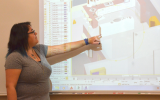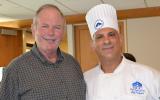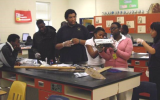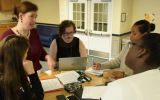Innovations
2017
Signal Brown, Information and Communication Technology instructor at Knox Community College, says that student-centered learning often needs to be gradually introduced so that students with no experience with this approach when they enter college become familiar with it and the chances of student success is increased.
Tags:
2017
Orville Beckford, Social Sciences faculty at Excelsior Community College and Mona Community College, discusses student success and completion from his perspective as a lecturer at two colleges in Jamaica.
Tags:
2017
Diana Lucio, a Public Administration instructor at South Texas College, discusses DegreeWorks, a collegewide, web-based program that allows students to track their degree plan progression.
Tags:
2017
Jimmy Adams, Dean, Media Arts & Technology Center of Excellence, at Houston Community College, talks about the barriers that effect student success, including life issues, and how his college is trying to identify and eliminate those barriers (e.g., issuing bus vouchers and emergency funds for child care).
Tags:
2017
Oniel Smith, a Mathematics lecturer at the College of Agriculture, Education and Science, discusses fforts to overcome student struggles in math classes, including a diagnostic test to determine their level of competence in mathematics and teaching in the Jamaican dialect as well as standard English so students are more likely to nderstand the vocabulary.
Tags:
2017
Maria del Rosario Villasana, Child Development and Family Studies Department Chair at City College of San Francisco, discusses the diverse student body in CTE programs and the many pathways available to her students for completion of either a certificate or degree.
Tags:
2017
Debbie Meyer, an English and History adjunct instructor at Pensacola State College, talks about giving students feedback and developing a relationship with them to help improve student retention.
Tags:
2017
Teri Denman, assistant to two deans in Academic Affairs at Estrella Mountain Community College, discuss a leadership/professional development program developed by a residential psychology faculty member at her college, reflecting the college’s core values of innovation, diversity, and collaboration.
Tags:
2017
Nathan Rom, Chairman of the Board, Montego Bay Community College, discusses his concern about what happens to students when they leave the college and enter the workforce and stresses the need to prepare students adequately for employment and industry.
Tags:
2017
Renne Emiko Brock, a Multimedia Communications instructor at Peninsula College, discusses the importance of finding community mentors to guide students to success and completion.
Tags:
December
2016
How many of you use technology to enhance your instructional practice? Do you feel it’s a challenge to get students to use and understand it? Over the last few years, I’ve had a love-hate relationship with technology and its value. I know technology can be very supportive in the right situation, like assisting students with disabilities. I’m often torn about when to use it and how to get the best return on my investment. However, I have found a few tools that my students seem to respond to and that are fairly easy to use.
The first tool, WriteLab, is an online tool that provides students with...
Tags:
December
2016
I never cease to be thrilled to see new buildings under construction on campus. Blank spots are filled in and meld into our daily comings and goings. The bare uprights represent growth and vitality framing our mission as well as tangible community support since many new building projects come about through large-scale bond initiatives. Structural change in higher education once meant just this—new buildings to house fresher, technologically advanced classrooms, laboratories, and learning spaces for more and more students. As important as new buildings and infrastructure renovations are to our...
Tags:
December
2016
I’m always looking for ways to help students succeed; when students perform well, my life and job are easier. So, when I read about psychological interventions several years ago, I was enamored by the possibilities and what student success would look like using brief, or small interventions. These psychological interventions help build tenacious students: those who believe they belong in school academically and socially, and that school is relevant to their future; who seek out challenges and value effort as a learning experience; who view setbacks as an opportunity for learning; and who aren...
Tags:

Bob Klepac is breaking down the notion that architecture means four walls and a roof. For example, he told a Del Mar College class one morning last summer that one of his former students is designing a meal tray for passenger jets at Boeing. “He’s making over $120,000 a year doing that,” he said.
Klepac, a technical drafting instructor, was a lively observer that day as students in his Technical Animation and Rendering class presented their final projects. The 12-week course introduced them to three-dimensional (3D) computer modeling and the software language of computer-aided design. Their...

Move over kale; the latest trendy vegetable comes from the sea. It’s kelp!
Kelp is a slippery brown seaweed that grows in shallow waters along coastal areas. This unlikely ingredient is on the menu at Norwalk Community College (NCC), where the Hospitality Management and Culinary Arts programs have partnered with marine biologist Charles Yarish, Ph.D., to harvest kelp for research and to promote its nutritional benefits.
Kelp is a powerhouse of vitamins and minerals. It is used in many Asian cuisines and contains the highest natural concentration of calcium of any food source. It’s also high...
Tags:

To address the representation gap in the sciences, a partnership of institutions implemented two different early college/dual enrollment courses for high school students as part of a larger project. One program was a concurrent (in-school) enrollment program, and the other was a summer residential program. Each program ran for five years, and all of them successfully prepared students for college STEM. Many students entered STEM programs in college, and 80 percent of them are still there today.
The Larger Project
The Minority Student Pipeline Math and Science Partnership—(MSP)2—was a joint...
November
2016
A faculty member friend of mine, Dr. Karen Hattaway, tells the story of a student in her writing class who stood up about six weeks into a 16-week course and said, “I finally get it! You want us to cite the article so the other person can find the source! I could see it all along, and I couldn’t figure out why you kept telling me to sight it.” Wow—for over a third of the term, this student had no idea what this award-winning, caring, articulate professor meant when she was asking the class to cite sources, which is such a commonplace task in professional writing, that experts can easily...
Tags:

It’s crunch time on campus at Onondaga Community College (OCC). Spring semester final exams are just over a week away. In Professor Kristen Costello’s Microeconomics (ECO 204) class she’s discussing final project options with students. “You can do either a paper or a presentation,” Costello said. “If you choose a presentation you can do so as an individual or in a group of up to three people.”
Costello is holding class in the lounge of one of the college’s four residence halls. This particular residence hall is the home of Business majors who reside in one of the college’s Living Learning...
November
2016
Student success is certainly an educational buzz word. But honestly, what institution would claim not to want their students to succeed? The concept may be familiar, perhaps even hackneyed, but as faculty and students know, success is not automatic, and it isn’t easy. We’re rather intense about student success at San Jacinto College, and we’re always reviewing what we actually mean by that phrase and how we can practice what we preach. One innovative means to monitor student success in the moment is a practice initiated by my esteemed colleague Barbara Lindsey Brown, the long-time, well-...
Tags:
November
2016
In education circles, the word completion seems to be everywhere. But as Inigo Montoya said in The Princess Bride: “You keep using that word. I do not think it means what you think it means.” What does completion mean? One source of confusion and angst about this topic in higher ed is that it is entirely possible that completion means significantly different things to colleges than it does to state and federal legislators than it does to the public in general. And what about students? What does completion means for them personally?
With everyone from the Department of Education to the White...
Tags:










